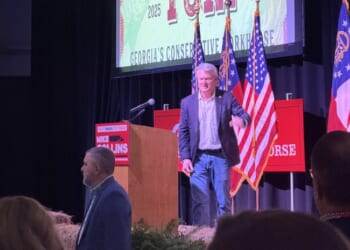The Threat Status team from The Washington Times goes behind the scenes of AUSA 2025, exploring the themes and the tone being set for tech advancements in the U.S. military.
National Security Editor Guy Taylor and lead NATSEC Tech Correspondent John T. Seward take a look.
[TAYLOR] One of the more interesting things behind the scenes, going around and talking to industry — more than a dozen companies that we’ve interacted with, drone makers, radar makers, integrators — is the way that private industry has really responded to the tone set by Army Secretary Driscoll on the first day of AUSA 2025: That there needs to be a revolution in how fast the acquisition process moves to get new advanced technology into the warfighters’ hands, the extent to which war gaming may play a bigger role, and that we don’t just have “let’s do a demo” and demos for demos’ sake.
[SEWARD] They’re actually partnering with each other. There’s a lot of discussion about how the primes are talking about, “hey, we cannot just be all on our own anymore.” We have to partner with new, smaller, up-and-coming companies to meet this demand that Secretary Driscoll has thrown out there.
[TAYLOR] You did a story on the idea of small nuclear electricity-generating plates. Tell me a little bit about that.
[SEWARD] That’s right. Secretary Driscoll sat down with Department of Energy Secretary Chris Wright and they talked about trying to push nuclear energy forward. One of those pieces is actually small micro nuclear reactors. They’re mobile so that they can actually deploy it to the battlefield. Secretary Driscoll specifically talked about getting stuff out to the Pacific, where there would be high energy needs. We did a piece where we had of an exclusive interview with Valar Atomics, and they gave us a little bit of insight into what that development looks like and how they’re trying to meet a lot of those demands that Secretary Wright and Secretary Driscoll were putting on the industry to push this forward.
[TAYLOR] The Threat Status team sat down with Leonardo DRS, talking about their forward-leaning view of advanced radars and what’s deployed. That stuff can be seen on the Threat Status platform and our overall coverage of AUSA 2025.
[SEWARD] We also got about 10 minutes or so, one-on-one with Secretary Driscoll. We were able to ask him a couple of questions, and we put him in a little bit of a bind. But he agreed with the challenge, that all of this technology we’re seeing has to have a communications layer that can actually support all of it. One of the things that we’re looking forward to, they’re actually going to have project convergence and a little bit of testing with the 4th Infantry Division this March. So we’re looking forward to seeing how folks actually manage that challenge of getting all of these different new systems to talk to each other. But that’s going to be the big high-stakes game they play. If we put forward all of this tech, can we actually get it to the battlefield for work?
Get more Drones Unleashed from Threat Status
Click here to receive the daily Threat Status newsletter delivered directly to your inbox.












